The space shuttle Endeavour undocked from the International Space Station on Saturday and prepared to return a team of astronauts who broke the American space endurance record – the crew of Expedition 4 will have been in space for 194 days when the shuttle returns to Florida on Monday. The new crew of two Russians and one American will remain on board the station until October.
Second Spacewalk Goes Well
During a 5-hour spacewalk, astronauts Franklin Chang-D?az and Philippe Perrin completed installation of the Mobile Remote Servicer Base System on the International Space Station’s Mobile Transporter. This gives the Canadarm2 the ability to move around the station, assisting with construction and maintenance. The astronauts will perform their third and final spacewalk on Thursday to replace the Canadarm2’s wrist joint.
In a 5-hour spacewalk today, Endeavour astronauts Franklin Chang-D?az and Philippe Perrin completed installation of the Mobile Remote Servicer Base System, or MBS, on the International Space Station?s railcar, the Mobile Transporter. With those tasks completed, they established a moveable base for future use by the station?s robotic arm, Canadarm2.
Chang-D?az and Perrin ventured outside the station?s Quest airlock at 10:20 a.m. Central time. With the help of Pilot Paul Lockhart, who guided the spacewalk from inside the shuttle, Chang-D?az and Perrin first connected primary and backup cables for video and data, and primary power cables between the Mobile Transporter railcar and the MBS. Once the connections were made, ground controllers sent commands for the MT to remotely plug in its umbilical attachments to receptacles on the S0 (S-Zero) truss railway.
With that complete, Chang-D?az and Perrin then deployed an auxiliary grapple fixture on the MBS called the Payload Orbital Replacement Unit Accommodation, or POA, and placed it in its final configuration. Identical to the end effectors on Canadarm2, the fixture can grapple payloads and hold them as they are moved along the station?s truss atop the MBS.
Continuing to run ahead of schedule, the two spacewalkers then secured four bolts between the MBS and the railcar, completing installation of the new MBS platform. Later this month or next, Canadarm2 will ?walk off? the Destiny Laboratory and mate its free hand to any one of four power and data fixtures on the new platform so it can be driven up and down the length of the station?s truss for use in future station assembly and maintenance operations.
The spacewalkers then relocated a television camera to its final position on top of a mast atop the MBS. The camera will provide views of station assembly and maintenance operations to ground controllers. Final tasks included adding an extra extension cable for the platform, a wire tie to one of the cables installed earlier during the spacewalk and to photograph connectors near the lower portion of the MBS that tie into the MT.
Following an inventory of the tools they used during the spacewalk, Perrin and Chang-D?az re-entered Quest. Airlock repressurization began at 3:20 p.m. Central time, signaling the end of the spacewalk. It was the 40th spacewalk in support of ISS assembly and maintenance and the second of the mission, bringing the total spacewalking time for STS-111 to 12 hours and 14 minutes.
After flight controllers verified that all connections on the Mobile Remote Servicer Base System were working properly, the capture latch on Canadarm2 was released. The arm, which had been supplying power to the MBS, was then repositioned for Thursday?s third and final spacewalk of the mission, which will see replacement of its wrist roll joint.
Handover conferences between the two Expedition crews and the transfer of equipment and supplies to the Leonardo Multi-Purpose Logistics Module also continued today. Working ahead of schedule, the crew continued to refill the module with unneeded supplies to be returned to Earth.
At 9:19 Central time tonight, Endeavour crewmembers and former Expedition Four Flight Engineers Carl Walz and Dan Bursch will set a new U.S. space endurance record, exceeding Shannon Lucid?s record of 188 consecutive days spent in space. Walz will set another record in the process, exceeding Lucid?s U.S. record for cumulative days spent in space as he reaches 223 days accrued over the course of five flights. Expedition 4 Commander Yury Onufrienko has spent a total 381 days in space, but remains far behind the world record for time in space of 747 days, held by Sergei Avdeyev.
The next STS-111 status report will be issued Wednesday morning after crew wakeup, or earlier, if events warrant.
Original Source: NASA News Release
ESO Captures Image of Tarantula Nebula
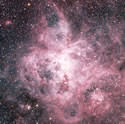
Image credit: ESO
The latest image released from the European Southern Observatory is of the Tarantula Nebula, located in the Large Magellanic Cloud approximately 170,000 light years from here. The nebula measures more than 1,000 light years across and covers the same amount of sky as the Moon. The image is a composite made up of 15 individual exposures taken with the 2.2m telescope at La Silla Observatory in Chile.
The largest emission nebula in the sky, the Tarantula Nebula (also known as NGC 2070 or 30 Doradus) is located in the Large Magellanic Cloud (LMC), one of the satellite galaxies to our own Milky Way system. Seen far down in the southern sky at a distance of about 170,000 light-years, this beautiful nebula measures more than 1000 light-years across and extends over more than one third of a degree, almost, but not quite the size of the full moon. It received its descriptive name because of the unusual shape.
It is a splendid object with a central cluster of hot and luminous young stars that powers strong emission from hydrogen and oxygen gas, making the Tarantula Nebula an easy and impressive target for observations, even with the unaided eye. It is well visible from ESO’s mountain observatories at La Silla and Paranal in Chile and it has been the object of innumerable research programmes with many different telescopes.
The present images of the Tarantula Nebula were obtained with the Wide-Field Imager (WFI) on the MPG/ESO 2.2-m telescope at the La Silla Observatory. This advanced digital camera has already produced many impressive pictures, cf. the WFI Photo Gallery [1].
As the name indicates, the WFI has a comparatively large field-of-view, 34 x 34 arcmin2, and it is therefore well suited to show the full extent of this stunning nebula.
The WFI image
PR Photo 14a/02 has been produced from 15 individual WFI-exposures obtained in September 2000. Details are available below about the way it was made.
A large number of different and colourful objects are seen in this amazing image. The very complex nebulosity is prominent in most of the field; it predominantly emits red light from hydrogen atoms (the H-alpha spectral line at wavelength 656.2 nm) and green-blue light from hydrogen atoms (H-beta line at 486.2 nm) and oxygen ions (two [O III] lines at 495.7 and 500.7 nm).
This emission is excited by the strong ultraviolet (UV) radiation emitted by hot young stars in the central cluster (known as “R136”) which were born 2-3 million years ago at the heart of the Tarantula Nebula.
Throughout the field, there are several other smaller, young open stellar clusters that are still embedded in nebulosity. Two globular clusters can also be seen, NGC 2100 at the very left of the field-of-view (see PR Photo 14d/01 below), and KMHK 1137 at the upper right (PR Photo 14e/01) [2].
Note the very different colours of these two globular clusters: the stars in NGC 2100 appear blue and bright, indicating their relative youth, whereas those in KMHK 1137 are fainter and much redder, due to their older age and possibly also the reddening effect of dust in this area.
The entire field is full of stars of very different colours and luminosity – most of them belong to the LMC, but some are foreground objects in our own galaxy, the Milky Way.
Original Source: ESO News Release
Astronauts Complete First Spacewalk
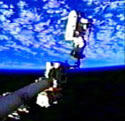
Image credit: NASA
Endeavour Astronauts Franklin Chang-D?az and Philippe Perrin performed a 7-hour, 14-minute spacewalk on Sunday, completing all the tasks on their plate. The astronauts installed a Power and Data Grapple Fixture to the station?s P6 truss, which will be used as a handle to move the truss around in the future. They also retrieved micrometeorite shields from the shuttle, which will be installed in July. Finally, the took a look at a gyroscope that recently failed on the station to help determine what might have caused it to malfunction.
Endeavour Astronauts Franklin Chang-D?az and Philippe Perrin completed all scheduled International Space Station assembly tasks today during a 7-hour, 14-minute spacewalk, the first ever for the duo.
Chang-D?az and Perrin ventured outside the station?s Quest airlock at 10:27 a.m. Central time. With the help of Endeavour Pilot Paul Lockhart, who guided the spacewalk from inside the shuttle, Chang-D?az and Perrin first installed a Power and Data Grapple Fixture to the station?s P6 truss. The fixture will be used to relocate the P6 truss structure to its final location on the station.
Attached to a foot restraint at the end of the station?s robotic arm, Canadarm2, operated by Expedition Five Flight Engineer Peggy Whitson and ISS Commander Valery Korzun, Chang-D?az gathered six micrometeoroid debris shields from the shuttle cargo bay and, with help from Perrin, temporarily stored them on Pressurized Mating Adapter-1 which links Unity to Zarya. Whitson and Korzun will install the shields on the Zvezda Service Module during a spacewalk set for late July.
Chang-D?az then conducted a visual and photographic inspection of one of the station?s four control moment gyroscopes on the station?s Z1 truss, a task that was added to today?s spacewalk after the gyroscope experienced a mechanical failure yesterday. The photos may help ground controllers better understand why the gyroscope failed.
Removal of thermal blankets from the Mobile Remote Servicer Base System or MBS was the final task of the spacewalk. At 5:21 p.m. Endeavour Commander Ken Cockrell commanded the release of latches that had secured the MBS to its carrier in the payload bay. Whitson and Carl Walz then latched onto the MBS with Canadarm2, removed it from its carrier, and maneuvered it to a position about three feet above the station?s railcar, the Mobile Transporter. Canadarm2 will be left in a parked position overnight to thermally condition the MBS before it is mated to the railcar Monday.
Later, the Canadarm2 robotic arm will be commanded to ?walk off? its position attached to the Destiny Laboratory onto a Power and Data Grapple Fixture atop the MBS. The arm will then be able to move up and down along the station truss for use in future assembly operations.
Following an inventory of the tools they used during the spacewalk, Perrin and Chang-D?az re-entered Quest. Airlock repressurization began at 5:41 p.m. Central time, signaling the end of the spacewalk. The next STS-111 status report will be issued Monday morning, or earlier, if events warrant.
Original Source: NASA News Release
Endeavour Docks with Station
The space shuttle Endeavour linked up with the International Space Station, providing supplies and a new crew – Expedition 5. Docking occurred at 1625 GMT (12:25pm EDT), slightly behind schedule because the shuttle approached the station more slowly than planned.
Hubble’s Infrared Camera Working Again
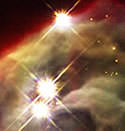
Image credit: Hubble
The Hubble Space Telescope’s Near Infrared Camera and Multi-Object Spectrometer (NICMOS) is functioning again, thanks to the refurbishing it got from a recent space shuttle mission. The telescope’s infrared capabilities ended when the NICMOS ran out of coolant three years ago. To showcase its capabilities, Hubble controllers release a series of images today, including the Cone Nebula – brilliant in infrared.
After more than three years of inactivity, and thanks to a new cryogenic refrigerator, the Hubble Space Telescope’s Near Infrared Camera and Multi-Object Spectrometer (NICMOS) today debuts various breathtaking views of galaxies in several stages of development.
The first NICMOS test images demonstrate its powerful new capability for making remarkable discoveries unique to space-based near-infrared astronomy. The NICMOS’s penetrating vision sliced through the edge-on dusty disk of a galaxy, NGC 4013, to peer all the way into the galaxy’s core. Astronomers were surprised to see what appears to be an edge-on ring of stars, 720 light-years across, encircling the nucleus. Though such star-rings are not uncommon in barred spiral galaxies, only NICMOS has the resolution to see the ring buried deep inside an edge-on galaxy.
Shifting its infrared vision to our stellar backyard, NICMOS peeled back the outer layers of the Cone Nebula (also photographed by Hubble’s Advanced Camera for Surveys in April) to see the underlying dusty “bedrock” in this stellar “pillar of creation.”
“It is fantastic that we have restored Hubble’s infrared eyesight. NICMOS has taken us to the very fringes of the Universe and to a time when the first galaxies were formed. We can’t wait to get back out there,” said Dr. Rodger Thompson, NICMOS Principal Investigator, University of Arizona, Tucson.
Installed on Hubble in February 1997, NICMOS used infrared vision to probe dark, dusty, never-before-seen regions of space with the optical clarity that only Hubble can provide. Its infrared detectors operated at a very cold temperature (minus 351 degrees Fahrenheit, which is minus 213 degrees Celsius or 60 Kelvin).
To keep the detectors cold, NICMOS was encased in a thermos-like container filled with solid nitrogen ice. It was expected that the solid nitrogen ice would last approximately four years. However, the ice evaporated about twice as fast as planned and was depleted after only 23 months of NICMOS science operations. In 1999 ? with its supply of ice exhausted ? NICMOS became dormant.
Determined not to be defeated, NASA scientists and engineers devised a plan to restore NICMOS to life. They turned to a new mechanical cooling technology, jointly developed by NASA and the U.S. Air Force. The NICMOS Cooling System (NCS) was built by NASA’s Goddard Space Flight Center, Greenbelt, MD, and the Creare Corporation, Hanover, NH.
The mechanical cooler operates on principles similar to a modern home refrigerator. It pumps ultra-cold neon gas through the internal plumbing of the instrument. At its core are three miniature, high-tech turbines that spin at rates up to about 430,000 rpm. Since the speed of the turbines can be adjusted at will, the NICMOS light sensors can be operated at a more optimal temperature than was possible before, about 77 Kelvin (minus 321 degrees Fahrenheit).
The NICMOS cooling system is virtually vibration-free, an important aspect for Hubble since vibrations can affect image quality in much the same way that a shaky camera produces blurred pictures.
“The Hubble Space Telescope Servicing Mission 3B is now demonstrated to be a complete success. We had 100 percent servicing mission success, and now we have 100 percent performance success for the newly installed NICMOS Cooling System,” said Dr. Ed Cheng, HST Development Project Scientist from NASA’s Goddard Space Flight Center.
Astronauts installed the NCS inside Hubble during the fifth and final spacewalk of Servicing Mission 3B on March 8, 2002. On March 18, the NCS was turned on via commands sent from the Space Telescope Operations Control Center at Goddard. It has continued to operate flawlessly ever since. The deep interior of the NICMOS reached the target temperature of 70 Kelvin (minus 333 degrees Fahrenheit) on April 11. Most of the internal heat had been removed from the instrument, and the NCS stabilized itself at this temperature. On April 19, NICMOS was brought up to a fully operational state and testing of its internal condition began. Since then, fine adjustments have been made to the settings of the NCS to optimize the instrument for best performance.
Original Source: Hubble News Release
Astronomers Find More Red Quasars
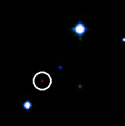
Image credit: NASA
A team of astronomers from the Space believe that red quasars may be more common in the Universe than previously thought. Quasars are bright, distant objects and the current theory is that they are caused by the black holes that reside at the centre of galaxies – because they’re so hot, they usually appear blue. Red quasars are largely obscured by dust and were typically hard to find in visible light, but they can be found in infrared light. The team compared sky surveys in visible and infrared light and turned up 17 of the elusive red quasars.
Elusive red quasars may be more common than previously expected, according to a recent survey conducted by a research team headed by Dr. Mark Lacy, an astronomer at the Space Infrared Telescope Facility Science Center in Pasadena.
The team will display its report on June 3 at the American Astronomical Society meeting in Albuquerque, N.M.
“Every galaxy is thought to have contained a quasar at some point in its lifetime. We wanted a good estimate of the number of quasars existing early in the life of the universe to compare to the numbers of black holes we see in the centers of galaxies today,” Lacy said.
Quasars are thought to be caused by black holes that reside at the centers of galaxies and attract matter from their host galaxies. As the matter falls into the black hole, it heats up and glows brightly, producing a quasar. Because the gas is so hot, many quasars appear very blue in color. Red quasars, however, have smoke-like dust in front of them. This dust absorbs the blue light from the quasar, making it appear redder and fainter than it would otherwise.
Red quasars, which are less common than normal quasars, are difficult to detect because their colors make them hard to distinguish from stars. To find red quasars, Lacy and his team first matched two surveys revealing the positions of existing quasars, among other objects. The two surveys used were the near-infrared Two Micron All-Sky Survey, carried out by the University of Massachusetts and processed at the JPL/Caltech Infrared Processing and Analysis Center in Pasadena, and the Faint Images of the Radio Sky at Twenty-centimeters survey, conducted by R.H. Becker, R.L. White, and D.J. Helfand using the Very Large Array, about 50 miles west of Socorro, New Mexico.
To determine which of the existing quasars were red, the team then used digitized Palomar Observatory sky survey plates, which show images of the sky in visible light. Red quasars were faint or invisible in these plates because of the dust in front of them, but were detected in the infrared. Halfway through their project, Lacy and his team had already found 17 of the reddest quasars known.
“Seventeen is a big number because it implies that there are a lot more red quasars in the universe that we have yet to find,” Lacy said.
Lacy’s team suspects there are many quasars that are even redder than those they observed. They believe these objects, called Quasar-2’s, are just as common as normal quasars. These highly reddened quasars were undetectable through their methods; however, other surveys have reported that they exist.
Lacy co-authored the report with M. Gregg and R.H. Becker, University of California, Davis and the Institute of Geophysics and Planetary Physics Lawrence Livermore National Laboratory, Livermore, Calif.; R.L. White, the Space Telescope Science Institute, Baltimore, Md.; and E. Glikman and D.J. Helfand, Columbia University, New York, N.Y.
The Faint Images of the Radio Sky at Twenty-centimeters survey is supported by the National Science Foundation, Arlington, Va.; the Institute for Geophysics and Planetary Physics Lawrence Livermore National Laboratory; the California Space Institute of the University of California; the Space Telescope Science Institute; Columbia University; Sun Microsystems, Santa Clara, Calif.; the North Atlantic Treaty Organization, Brussels, Belgium; and the National Geographic Society, Washington, D.C.
The Space Infrared Telescope Facility Science Center will handle science operations for the Space Infrared Telescope Facility mission, launching next year. The mission is managed by NASA’s Jet Propulsion Laboratory, Pasadena, Calif., for NASA’s Office of Space Science, Washington, D.C.
Original Source: NASA/JPL News Release
Odyssey Gets More Sensitive
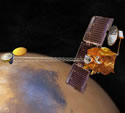
Image credit: NASA
Flight controllers for the Mars Odyssey completed a milestone on Tuesday when they ordered the spacecraft to extend the boom 6.2 metre boom that holds its gamma ray spectrometer sensor head instrument. Even though it hadn’t been deployed yet, the instrument was still able to collect data from Mars’ surface, but this extension will make it much more sensitive. The operation went off without a hitch.
Flight controllers for NASA’s Mars Odyssey spacecraft completed the last major technical milestone today in support of the science mission by unfurling the boom that holds the gamma ray spectrometer sensor head instrument.
Engineers at NASA’s Jet Propulsion Laboratory, Pasadena, Calif., received confirmation from the spacecraft that the 6.2-meter (20-foot) boom was successfully deployed at noon Pacific time.
The gamma sensor head is part of the gamma ray spectrometer suite. It sits at the end of the boom to minimize interference from any gamma rays coming from the spacecraft itself. The two other gamma ray spectrometer instruments, the neutron spectrometer and the high-energy neutron detector, are mounted on the main spacecraft structure.
During the past few months, while the boom was in the stowed position, the instrument suite has provided significant information about the hydrogen abundance on Mars. This allowed scientists to conclude there are large quantities of water ice just below the surface.
“Deploying the boom enhances the sensitivity and accuracy of the gamma ray spectrometer instrument and will improve the accuracy of the hydrogen measurements,” said Dr. William Boynton, principal investigator for Odyssey’s gamma ray spectrometer suite at the University of Arizona, Tucson. Now the instrument will begin measuring many other important elements such as iron, aluminum, potassium, chlorine, thorium, uranium and others.
“Today’s deployment is a continuation of the excellent performance of this flight team. They have done an outstanding job,” said Roger Gibbs, Odyssey’s project manager at JPL. “I look forward to many exciting discoveries to come as we continue our mission.”
JPL manages the 2001 Mars Odyssey mission for NASA’s Office of Space Science, Washington, D.C. Principal investigators at Arizona State University in Tempe, the University of Arizona in Tucson, and NASA’s Johnson Space Center, Houston, operate the science instruments. Additional science investigators are located at the Russian Space Research Institute and Los Alamos National Laboratories, New Mexico. Lockheed Martin Astronautics, Denver, is the prime contractor for the project, and developed and built the orbiter. Mission operations are conducted jointly from Lockheed Martin and from JPL, a division of the California Institute of Technology in Pasadena.
Original Source: NASA/JPL News Release
Ariane Rocket Launches Intelsat Bird
An Ariane 44L rocket successfully launched an Intelsat 905 telecommunications satellite into orbit on Wednesday – liftoff was at 0644 GMT (2:44am EDT) from Kourou, French Guiana. Once in its final position, the Intelsat 905 will provide Ku-band coverage for much of North America and Western Europe. This was the seventh launch of the year for Arianespace.
No More Delays, Endeavour Launches
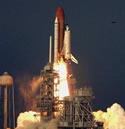
Image credit: NASA
With the weather finally on side for NASA, the space shuttle Endeavour blasted off Wednesday afternoon from Florida’s Cape Canaveral. The shuttle launched at 2122 GMT (5:22 EDT) carrying the crew of Expedition 5 into orbit, bound for the International Space Station. Endeavour will dock with the station on Friday and relieve the 3-man crew of Expedition 4. Shuttle astronauts will also perform 3 spacewalks to install some additional components onto the station.
With improved weather conditions at the Kennedy Space Center, Endeavour lifted off at 4:23 p.m. CDT today, beginning a complex mission to continue the assembly and maintenance of the International Space Station and bring a new trio of residents to the orbital outpost.
Aboard Endeavour are Commander Ken Cockrell, Pilot Paul Lockhart, Mission Specialists Franklin Chang-D?az and Philippe Perrin of the French Space Agency, CNES, along with Expedition 5 Commander Valery Korzun and Flight Engineers Peggy Whitson and Sergei Treschev. As Endeavour launched from Florida, the space station orbited 240 statute miles over the southern Indian Ocean west of Perth, Australia.
Aboard the ISS, Expedition 4 Commander Yury Onufrienko and Flight Engineers Carl Walz and Dan Bursch are wrapping up their 182nd day in space, their 180th day on the station. Walz and Bursch will break the U.S. record for the longest single space flight ? 188 days ? set by astronaut Shannon Lucid in 1996. Another record was equaled today as Chang-D?az became only the second human to fly in space seven times, tying a mark set in April by Jerry Ross on the STS-110 mission.
Less than nine minutes after launch, Endeavour and its crewmembers settled into orbit and work began to prepare the shuttle for its planned 12-day mission.
Endeavour is scheduled to dock to the station Friday afternoon, setting the stage for the handover between the Expedition 4 and Expedition 5 station crews. Three spacewalks are scheduled during the mission by Chang-D?az and Perrin. The first two will help install and activate the Mobile Base System, a platform that will be mated to the Mobile Transporter on the S-Zero (S0) Truss. The new platform will allow the station?s Canadarm2 robotic arm to ?walk off? the Destiny Laboratory onto the Mobile Base System so it can be transported up and down the length of the ISS for future assembly tasks. On the third spacewalk, Chang-D?az and Perrin will replace a faulty wrist roll joint on the station?s robotic arm that has experienced an electrical problem in one of its two data and power channels.
The shuttle crew will go to sleep at 10:23 p.m., and will be awakened at 6:23 a.m. Thursday to begin its first full day in orbit. The next STS-111 mission status report will be issued Thursday morning after Endeavour?s crew is awakened.
Original Source: NASA News Release
